Seals? Seal Lions? Walruses? Do you know your fin-footed mammals?
| Pier 39 Sea Lions |
On a trip in the fall of 2012 to San Francisco to attend the Internet Archives’ Leaders’ Forum, a couple of us paid a visit to Pier 39 to visit the semi-aquatic mammals that hang out there.
Since January 1990, these colorful creatures have been “hauling up” at Pier 39. At first considered a bit of a nuisance (they can be a bit loud and smelly), they soon turned into a beloved tourist attraction. See more about their story on the Pier 39 site.
But what exactly are these creatures? Well, three families make up the group of fin footed mammals of the order, Pinnipedia: Odobenidae (the walrus), Otariidae (eared seals, sea lions, and fur seals), and Phocidae (earless seals).
Now your first question might be “what are these seals doing here?”, but are they seals? How does a seal differ from a sea lion? Or for that matter, how do either of them differ from a walrus? Walrus are pretty clear, they have tusks. No tusks here, so these must be either Otariidae or Phocidae. If we could get up close enough, we would see that these are indeed, Otariidae, or members of the sea lion family.
Phocidae (true seals) lack external ears, have streamlined snouts, and are more aquatic. Otariidae (sea lions, eared seals, and fur seals) hang out on land more than true seals, their fins more suited to “walking”. They’re furrier and more vocal. The so-called “circus seal” is actually a California Sea Lion, Zalophus californianus, the same as we find at San Francisco’s Pier 39.
The California Sea Lion (Zalophus californianus) was first illustrated in Louis Choris’s (1795-1828) Voyage pittoresque autour du monde avec des portraits de sauvages d’Amérique, d’Asie, d’Afrique, et des îles du Grand océan : des paysages, des vues maritimes, et plusieurs objets d’histoire naturelle (1822). However, the animal was not taxonomically described until 1828 when René Primevère Lesson first described it as Otaria californiana (in Dictionnaire classique d’histoire naturelle, par Messieurs Audouin, Isid. Bourdon, Ad. Brongniart, de Candolle, et Bory de Saint-Vincent. Ouvrage dirigé par ce dernier collaborateur…, 1822-31).
Taxonomic revision of the species occurred throughout the 19th and 20th centuries. It was recombined as Eumetopias californiana by Gill (1866); it was recombined as Eumetopias (Zalophus) californianus by Trouessart (1898) and Trouessart (1904); it was recombined as Eumetopias californianus by Turner (1912); it was recombined as Zalophus californiana by Hay (1930); it was recombined as Zalophus californianus by Allen (1880), Scheffer and Rice (1963), Vidal (1991), Rice (1998), Demere et al. (2003) and Wilson and Reeder (2005).
Though the Pier 39 seal lions are now a popular tourist attraction, the “seals” of the California coast have been remarked on for years. In his 1906 publication, California Mammals, Frank Stephens commented:
The following extracts from my notebook may be of interest. April first, 1893. This morning Mr. Fenn and I rowed to the ‘seal rocks’ near the south end of Santa Catalina Island to get sketches of the Sea Lions. As we neared the rocks we saw several Sea Lions on them and heard their loud ‘hong-hong.’ Several were on the outer group of islets, but none were on the outermost rock, which was perhaps a hundred feet from the islet on which the greatest number were lying. The morning was cloudy and calm, with but little sea, and we cautiously pulled up behind the rock which rose five or six feet above the water. Mr. Fenn got out on a little shelf that was awash when the larger swells passed. In front the rock was low enough to see over and made a rest for the sketch book. I had to keep clear of the rock to avoid smashing the boat and out of sight as much as possible, which was no easy job in the long swell.
And if you want to see what those Pier 39 Sea Lions are up to right now, take a look at the Sea Lion webcam!


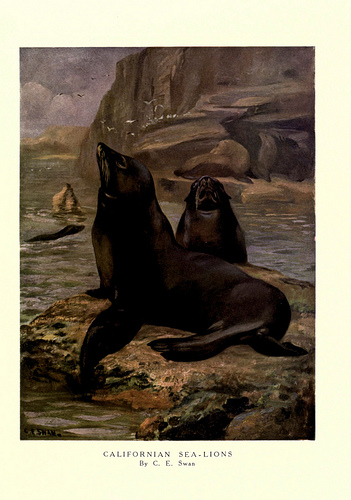
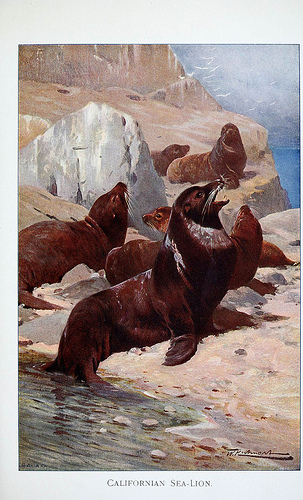
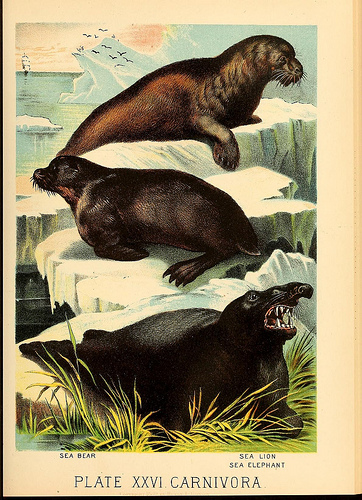
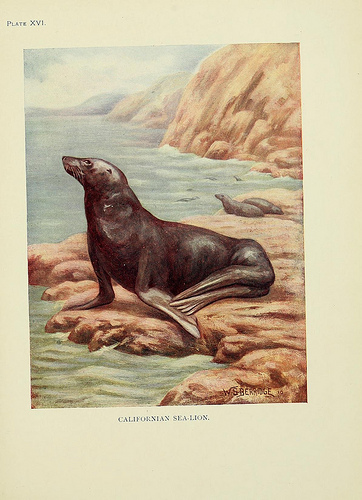

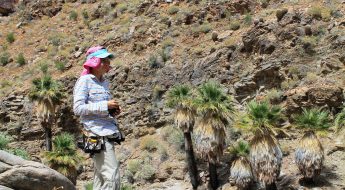

Leave a Comment